Learning Kanji and cooking words in Japanese
Anna Baffa Volpe
Get in touch with meHere we are, welcome back!
皆さん、お元気でお過ごしでしょうか。
In this post I will introduce the recipe of a Japanese dish in order to learn or review some useful cooking terms.
レシピ reshipi from the English word recipe
The dish we are introducing today has Chinese origins and has long been cooked and served in Japan as well.
- 日本料理 or 和食 means
Japanese cuisine - 中華料理 or simply 中華 refers to
Chinese cuisine
The Japanese Fried Rice 焼き飯 Yakimeshi


The Fried Rice very popular in Japan is called 焼き飯 Yakimeshi in Japanese, but the term チャーハン Chāhan is also used and derives from the Chinese word 炒饭 Chǎo fàn.
- 焼き yaki derives from the verb in the dictionary form yaku 焼く,
cook,toast,bake - 飯 this kanji has Japanese reading kun meshi and represents
riceas grain, but means alsomeal
チャーハンを家のキッチンで上手に作る。
Making fried rice skillfully in your home kitchen.
- 上手に is a widely used adverb in the Japanese language and means
good,skillfully; the adjective is 上手なgood at,skillful
We need for the recipe:
- ご飯
rice - 具材 the various
ingredients
プロ並みの味を作る裏ワザとは?
What are the secret tricks to make it tasty like a pro?
We have 2 terms for secret tricks:
- 裏技 urawaza 裏 indicates the
backside⇨ the secret and 技 is theartand thetechnique, here written in katakana to emphasise the term - 隠し味 kakushiaji: the verb 隠す means
hidecombined with the kanji oftaste味
Preparing
An important aspect in the Japanese cuisine as well as in other Asian countries is the habit of:
ご飯を水洗いすることだ。
Washing rice in cold water.
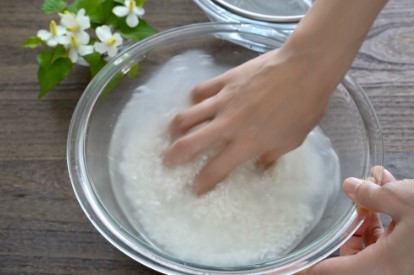
Why is it better to wash the rice well?
This dish in restaurants is prepared on a high heat cooker with a well-oiled wok so that the rice grains do not stick and remain crispy. At home, on the other hand, the cooker is often not powerful enough and one often does not have a wok.
Steeping the rice in cold water removes some of the starch and thus the stickiness, so it remains soft before being stir-fried.
実際に作り方を見ていきましょう。
Let's see how this dish is actually prepared.
Ingredients
We have seen the word 具材 and now we add:

This word 材料 refers to food ingredients in this case, but it is also the term used for various kind of materials: 木 wood and 金 metal are a type of 材料.
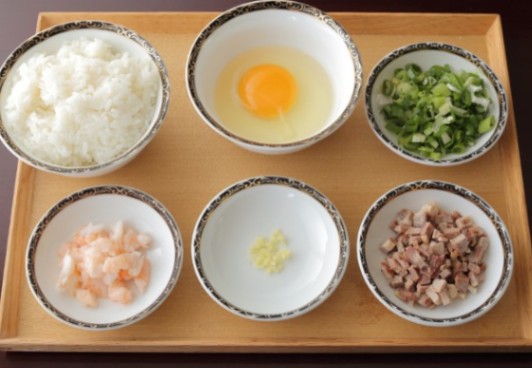
Here is the complete list of ingredients:
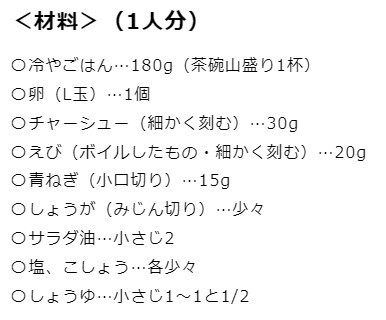
<材料>(1人分)Ingredients for 1 person
- 冷やごはん、茶碗山盛り1杯: 180 g rice soaked in cold water (one full cup)
- 卵、 L玉、1個: one large egg
Let's review the counters or numeric suffixes in Japanese, elements that indicate the category to which the object belongs.
In this case we have for the eggs the classifier 個 and for the cups 杯.
- チャーシュー、細かく刻む: 30 g of chāshū, the Japanese
braised pork belly, cut into fillets is also used astoppingof ramen.
The word derives from the Chinese char siu (叉燒) and the Japanese translation for this type of meat is 焼き豚, roast pork.
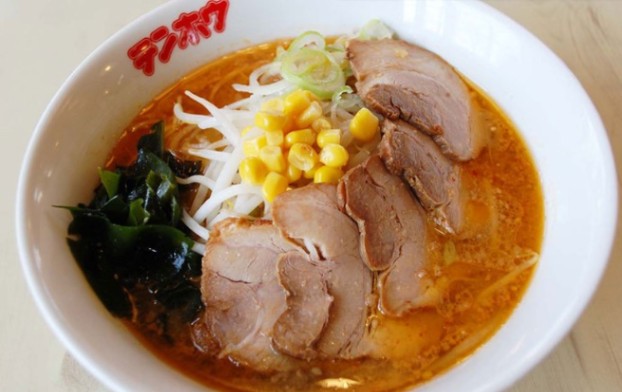
Cutting, chopping
Let's look at two expressions for cutting meat or vegetables:
- 細かく刻む
finely chop,cut fine - みじん切り
finely chop,mince
Dealing with a recipe, we often find the verb cutting expressed by 切る and 刻む; 刻む is also used in the artistic field with the meaning of carve, engrave, chisel.
- えび(ボイルしたもの、細かく刻む): 20 g of
shrimps, boiled and finely chopped - 青ねぎ、 小口切り: 15 g of
green onioncut into small pieces (小口) - しょうが、みじん切り、 少々: shōga, a type of finely chopped
ginger, in small quantity - サラダ油、 小さじ 2: 2 teaspoons of
salad oil; えび(ボイルしたもの、細かく刻む): 20 g ofshrimps, boiled and finely chopped
Cooking Measurement: Tablespoons and Teaspoons
Other units of measurement in cooking we commonly find in Japanese recipes are:
- 大さじ
tablespoon; (大) large, big - 小さじ
teaspoon; (小) small, little
調味料 Seasoning
- 塩、こしょう、各少々:
salt and pepper, a little (少々) for each (各) - しょうゆ: 小さじ1〜1と1/2: 1 or 1½ teaspoon of
soy sauce, which is essential in most Japanese dishes
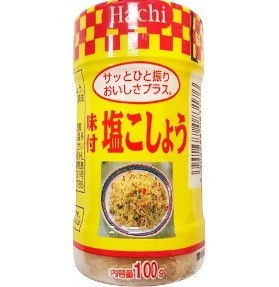
焼き飯の作り方 How to make Yakimeshi
1.フライパンにサラダ油、しょうがを入れて中火にかける。
Put the salad oil and ginger in a frying pan over medium heat.
A note on ginger:
しょうがは風味づけではなく、油のにおい消しという理由で加えます。
Ginger is not added for flavouring, but to eliminate the smell of the oil.
In recipes we often find the verb:
- 加える
add,sum up,include
2.卵を加え、大きく混ぜる。
Add the eggs and mix thoroughly.
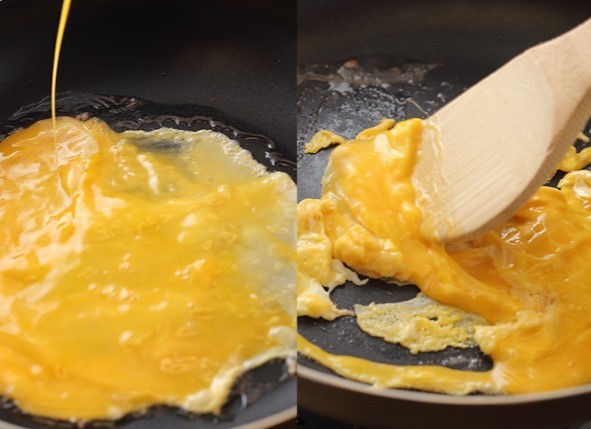
混ぜる Stirring
We have 2 forms translating the verbs mix, stir: 混ぜる or かき混ぜる.
油を十分に熱したら溶いた卵を一気に加え、木べらで大きくかき混ぜます。
When the oil is hot enough, add the beaten eggs in one go, stir vigorously with a wooden spoon.
3.ごはんを加え、ほぐすように炒める。
3. Add rice and stir-fry to break up the rice.
- ほぐす, the verb that appears in this passage means to
break up. It is used here in cooking with the meaning of mixing and making the whole mixture homogeneous, and it is also used to say: - 髪のもつれをほぐす
unravel hair
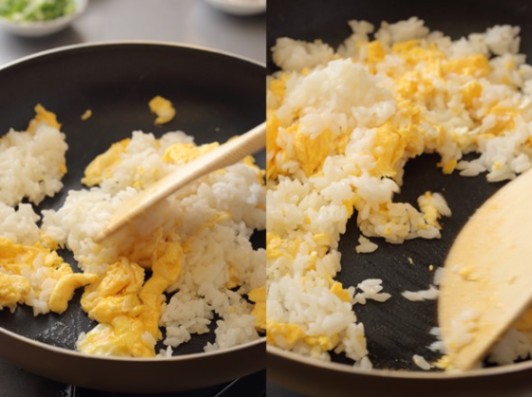
4.塩、こしょうをふる。
4. Sprinkle with salt and pepper.

ごはんと卵がよく混ざり、水分が飛んだら、塩、こしょうをふってさっと炒めます。
When the rice and eggs are well mixed and the water has evaporated, sprinkle with salt and pepper and fry quickly.
Note to the verb expressing mix:
- 混ぜる is the
transitive formof the verb: mix something. - 混ざる is the
intransitive form: when something is mixed
5.チャーシュー、えびを加える。
5. Add pork and shrimps.

6.青ねぎを加えてさっと炒める。
6. Add the green onions and stir-fry quickly.
- In this passage we find the て form of the verb:
- 加えて炒める
add and fry, two actions occurring at the same time
Frying, Stir-frying, Sautéing
A single verb that we translate differently depending on the 調理法 cooking method.
炒める can be translated as fry, saute, stir-fry.
You can find Yakimeshi as Japanese Fried Rice or Stir-Fried Rice.
The term saute is expressed by ソテー from French language sauté.

7.しょうゆを鍋肌から加え、さっと混ぜたら完成!
7. Add soy sauce from the edge of the pan and stir quickly.
Kitchen tricks
It is worth dwelling on an expression read in the previous step:
- 鍋肌から加える or
- 鍋肌から入れる:
add from the edge of the pan
鍋 is the pan edge and 肌 the skin and in this case we refer to the pan edges.
Generally the seasoning, soya in our recipe, is not poured directly onto the food in the pan, but onto the rim, so as to better amalgamate and enhance the flavour.
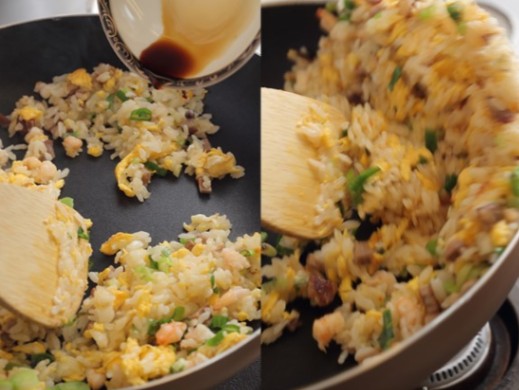
シンプルなのに 滋味深い! パラパラ 絶品 チャーハン の 完成: Simple, yet full of flavour! The exquisite crisp fried rice done!







